Cable Display Systems: Applications, Installation, and Maintenance
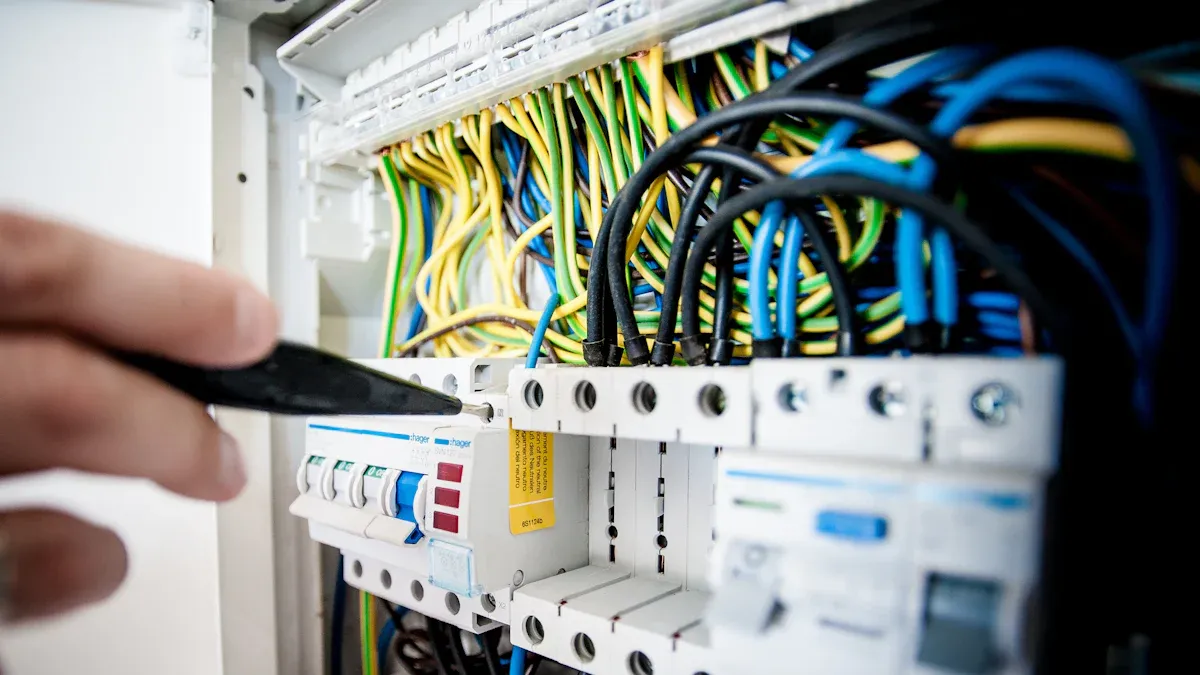
You can find cable display systems in museums, offices, and homes. People use them all over the world. Top brands have sold over 25,000 miles of track. This shows that many people trust these systems. Cable display systems look modern and stylish. They help you show signs, art, or important information. You can change your displays or move them easily. Many industries use them because they are simple to install. They are also easy to take care of and update. The table below explains how different places and industries use cable display systems.
Aspect | Details |
|---|---|
Cable Management Market CAGR | Asia-Pacific: 9.3% (fastest growth region) |
Leading Region (2024) | North America with 36.9% revenue share |
Fastest Growing Sector | Residential sector with 9.3% CAGR due to urbanization and demand for aesthetics and safety |
Key Industry Drivers | IT and telecom sectors largest revenue share; demand driven by data centers and networks |
Regional Highlights | India significant due to data centers and telecom expansion |
Market Drivers | Urbanization, infrastructure development, government projects, 5G technology adoption |
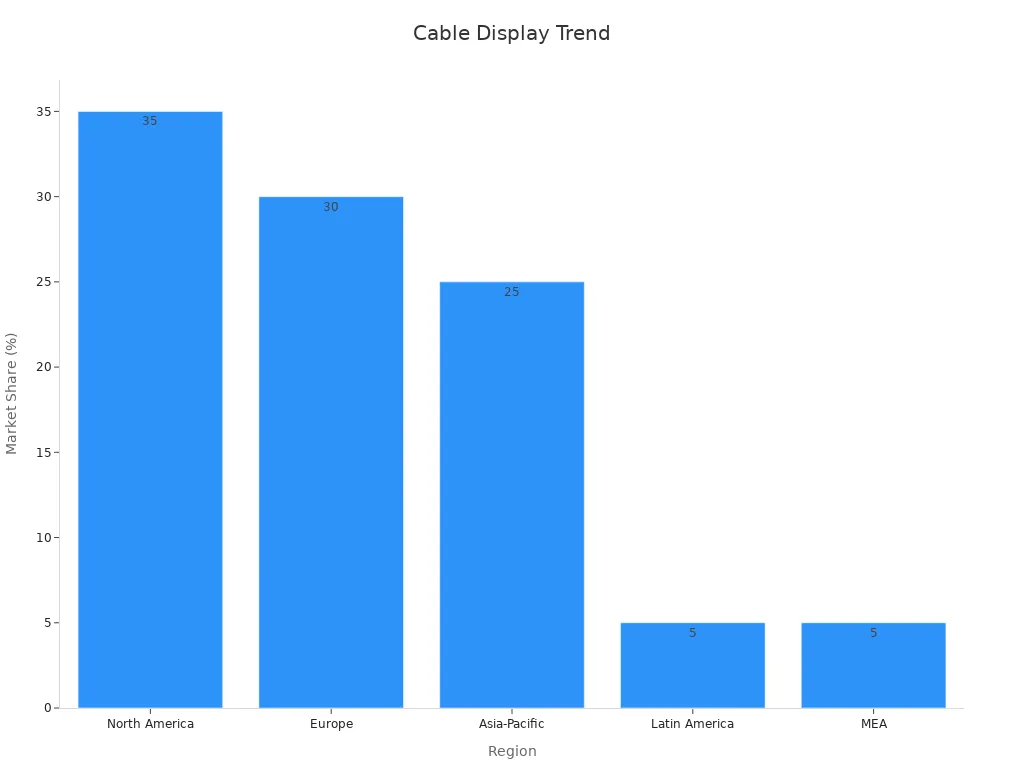
Key Takeaways
Cable display systems give a new and strong way to show signs, art, or information in many places like stores, offices, and schools. These systems are simple to set up and change. They use strong cables that can hold heavy displays safely. You do not need special tools. You can pick from different mounting styles like floor-to-ceiling, wall-to-wall, or track-mounted. This helps you fit your space and display needs. Checking and cleaning your cable display system often keeps it safe and working well. This helps you avoid expensive repairs. If you follow safety tips and use good parts when installing, you can stop injuries. This also helps your display system last a long time.
Cable Display Systems Overview
What Is a Cable Display System
A cable display system uses strong cables and fittings to hold up signs, posters, or artwork. You often see these systems in places where you want to show information in a modern way. The cables stretch between the floor and ceiling or between two walls. You can attach different types of displays to the cables. This setup lets you change your displays quickly. Most cable display systems use stainless steel or galvanized steel for strength and durability. You can trust these systems to hold heavy displays without bending or breaking.
Tip: You can use cable display systems for both small and large displays. They work well for art galleries, retail stores, and offices.
Key Features
Cable display systems stand out because of their strength and flexibility. Product tests show that a 1.5 mm cable can support up to 120 kg (264 lbs) at each suspension point. If you need to hang heavier displays, a 3.0 mm cable can hold up to 200 kg (441 lbs). These cables resist fraying and snapping, so you get long-lasting quality. You can choose from different cable diameters and materials to match your needs. The table below shows some common technical specifications:
Specification Aspect | Details |
|---|---|
Cable Diameter | 1.5 mm or 3.0 mm |
Material | Stainless steel or galvanized steel |
Load Capacity | 120 kg to 200 kg per point |
Benefits
You gain many benefits when you use cable display systems. They give your space a clean and modern look. You can move or update your displays without much effort. The system is user-friendly, so you do not need special tools or skills. You get high quality and safety because the cables hold heavy displays with ease. These systems also help you keep your displays organized and neat. You can trust cable display systems to last a long time and keep your displays looking sharp.
Cable Display Systems Applications
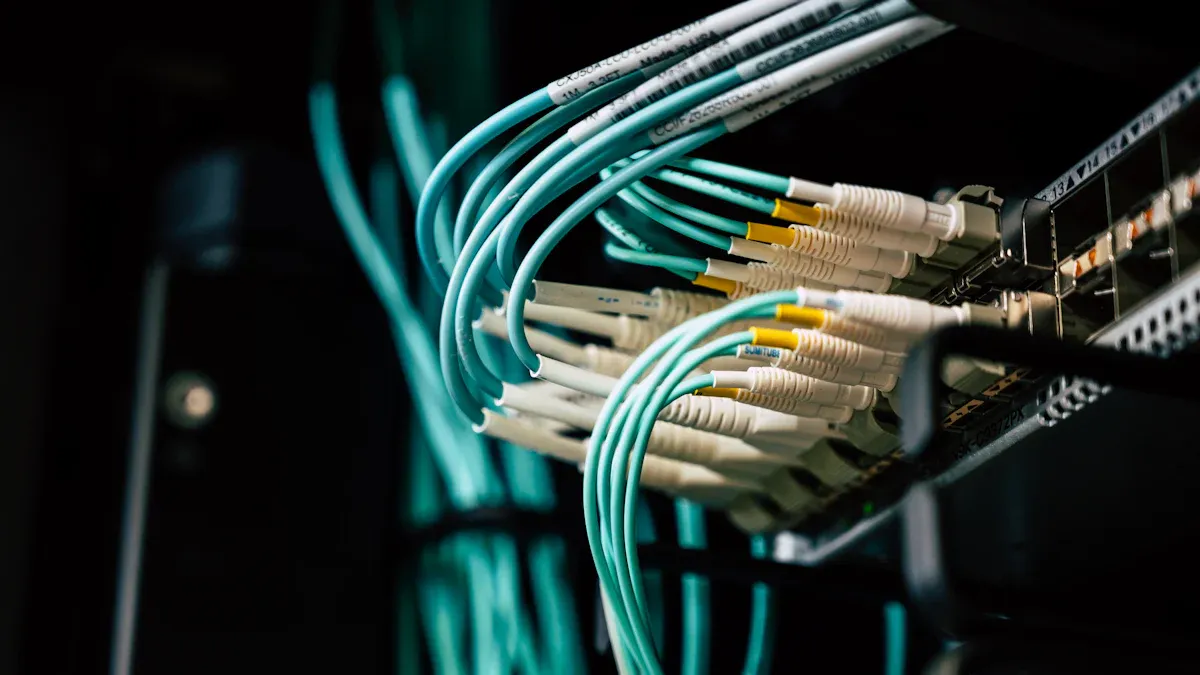
Cable display systems have many uses. You can see them in stores and offices. They help make displays that look modern and stand out. You can use them for signs that stay up or ones you change often. Many people pick them because they work in lots of places.
Most Popular Display Applications
Cable display systems are used in many ways. Some uses are for posters, signs, and banners. Businesses use them for shelves and showcases. You can make shelves that look like they float. Wall mounted uses are good when you want to save space or show off special things.
Tip: You can change your signs or displays fast. This is great for places where things change a lot.
Here are some common uses:
Retail window displays
Corporate lobby signage
Real estate property listings
Hospitality welcome boards
Educational information boards
Retail and Window Displays
Stores use cable display systems to make windows look nice. You can hang posters, banners, and shelves with them. This helps get people’s attention. Staff can change posters fast for new sales. Banners are good for special events or sales. Floating shelves help show off cool products.
Cable display systems let you change signs whenever you want. You can have signs that stay up or ones for short times. This helps your store always look new and fun.
Corporate and Office Displays
Offices use cable display systems to show important things. You can put signs in lobbies, meeting rooms, and halls. Many offices use wall mounted cable displays for lists or news.
The DVI Cable Market report says offices use cable display systems for more screens. This helps people work better and share info.
IT and telecom companies use these systems for clear pictures and safe data.
The U.S. Wires and Cables Market report says cable systems are key in office buildings. Copper wire helps with power and connections.
You can pick cable displays that stay up or ones you move for events. Permanent cable displays are called permanent links. They are strong and work well. Temporary signs are easier to move but may not always work the same.
Feature | Permanent (Wired) Installation | Temporary (Wireless) Installation |
|---|---|---|
Reliability | Very reliable because of real cables. | Not as reliable; can lose signal sometimes. |
Security | Very safe with closed cables. | Not as safe; needs extra protection. |
Data Transfer Speed | Very fast for big files. | Not as fast; can slow down with big files. |
Maintenance | Easy to fix cables and plugs. | Harder to fix; needs special tools. |
Flexibility | Not easy to move because of cables. | Easy to move anywhere in range. |
Ideal Applications | Good for signs that stay up. | Good for signs you move a lot. |
Other Environments
Cable display systems are also used in hotels, real estate, travel, and schools. Hotels use them for guest info and event signs. Real estate offices show home listings and banners. Airports and train stations use them for clear signs and info.
The table below shows real places that use cable display systems:
Environment Category | Venue / Location | Summary of Cable Display System Utilization and Audio-Visual Integration |
|---|---|---|
Hospitality | The Ritz-Carlton - Xi'an, China | Fancy hotel uses cable display and AV systems for a great guest stay. |
Hospitality | YMCA - Urbana, Maryland | Big center uses an IP audio system that can connect to other places. |
Real Estate / Alternative | World Equestrian Center - Ocala, FL | Huge horse park uses special audio for many event spaces. |
Real Estate / Alternative | Historic Turner Hall - Monroe, WI | Old building uses cable audio that looks nice with the décor. |
Transportation Hubs | World Trade Center Transportation Hub - NY | Big system uses cable and network tech for 250,000 people each day. |
Transportation Hubs | LaGuardia Airport - Queens, NY | Audio system uses CobraNet™ over IP for important messages. |
Transportation Hubs | Istanbul Airport - Istanbul, Turkey | Paging system uses cable AV for clear, reliable messages. |
Transportation Hubs | Los Angeles International Airport (LAX) | GLOBALCOM® system sends messages all over the airport and parking. |
Transportation Hubs | Seattle-Tacoma International Airport | Cable audio system helps everyone hear announcements clearly. |
Educational | Forest Hills Public Schools - Grand Rapids, MI | Sound system upgrades in many buildings use cable and IP tech. |
Educational | Johnson County Community College - Overland Park, KS | GLOBALCOM® system manages messages and alerts on campus. |
Educational | Genesee Valley School District | Old PA system replaced with strong cable communication tech. |
Educational | Alexandria Senior High School | Football stadium got better sound with cable-based speakers. |
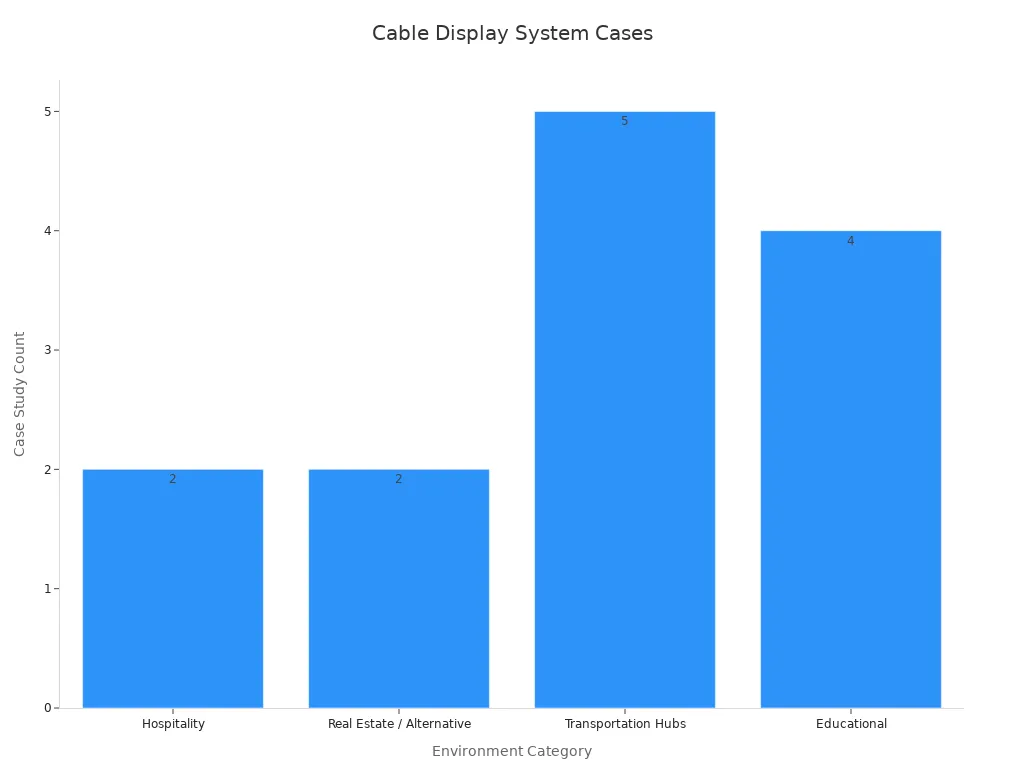
Cable display systems help with many types of signs. They let you show posters, signs, and banners. You can use them for signs that stay up or ones you change. They are flexible and work well for many jobs.
Components and Materials
Cables and Fittings
Cables and fittings are very important in cable display systems. These parts keep your displays safe and steady. Strong materials like stainless steel are used for strength. Tracks help you move things easily. Companies follow rules like UL 444 and ISO/IEC 11801 to make sure everything is good. They do pull tests, flex tests, and look for damage. Pull tests check if the cable can hold heavy displays. Flex tests see if the cable bends many times without breaking. These tests make sure your accessories are safe and work well. You can trust these cables because they pass many tests.
Tip: Look for a holographic label or certification mark on your accessories. This helps you know the product is real and high quality.
Mounting Options
There are different ways to mount your cable display systems. Floor-to-ceiling mounts are good for tall displays. Wall-to-wall mounts are best for small spaces or special signs. Some systems use tracks so you can move displays up or down. You do not need tools to change them. This makes it easy to update signs for new events. Clamps and brackets help you install everything safely and quickly.
Mounting Type | Best For | Key Feature |
|---|---|---|
Floor-to-ceiling | Large, open areas | Tall, stable displays |
Wall-to-wall | Tight or narrow spaces | Space-saving signage |
Track systems | Versatile layouts | Easy adjustability with tracks |
Display Materials
You can pick from many materials for your displays. Acrylic panels are clear and look modern. Glass feels fancy and strong. Lightweight plastics are good for signs you only use for a short time. Some systems can even hold shelves for products. All these materials must pass safety and quality checks. Testers look for things like fire safety and halogen content. This means your displays will last and stay safe. Sign holders and poster pockets help you change displays easily.
Installation
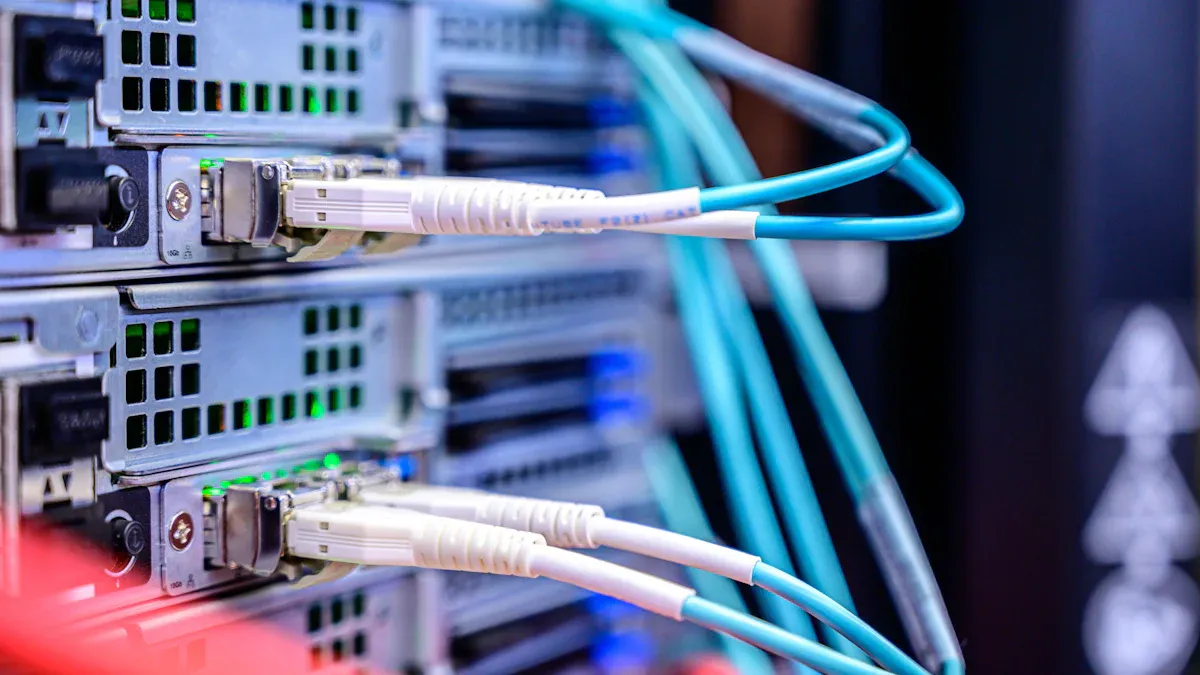
Planning
You need a good plan before you start any cable display system installation. Start by measuring your space. Decide where you want your displays. Think about how many panels or signs you want to hang. Make sure you have enough room for cables to stretch without bending. Check the weight of your displays. Choose cables that can hold the weight safely.
Many people find it easy to install cable display systems when they use a cable display kit. These kits come with all the parts you need, such as cables, fittings, and mounting hardware. You can follow the included installation guides to make the process smooth. Always check that your components match. Mixing the wrong parts can cause signal loss or weak displays. Use only cables and fittings that meet industry standards.
Tip: Write down your plan and double-check your measurements. This step helps you avoid mistakes and saves time later.
Configuration Options
You can set up cable display systems in different ways. The most common configurations are floor-to-ceiling, wall-to-wall, and track-mounted systems. Each option works best for certain spaces.
Floor-to-ceiling: This setup is great for open areas. You stretch cables from the floor up to the ceiling. It gives you a tall, stable display.
Wall-to-wall: Use this option in narrow spaces. You attach cables between two walls. This method saves space and keeps your displays neat.
Track-mounted: Tracks let you move your displays up or down with ease. You can change the height or position without tools.
You can also combine these options for a custom look. Many cable display kits support more than one configuration. This flexibility makes it easy to install displays in almost any space.
Step-by-Step Process
Follow these steps to complete your cable display system installation:
Gather Your Tools and Parts
Open your cable display kit. Check that you have all cables, fittings, and mounting hardware.
Read the installation guides that come with your kit.
Mark Your Mounting Points
Use a pencil to mark where you will attach cables on the floor, ceiling, or walls.
Double-check your measurements to keep everything straight.
Install the Mounts
Attach the floor, ceiling, or wall mounts using screws and anchors.
Make sure each mount feels secure before moving on.
Attach and Tension the Cables
Thread the cables through the mounts.
Use the tensioning system to pull the cables tight. This step keeps your displays stable.
Avoid over-tightening, which can damage the cables.
Add Display Holders or Shelves
Clip or slide your display holders onto the cables.
Adjust the height and position as needed.
Check for Level and Stability
Use a level to make sure your displays hang straight.
Gently shake the cables to test for movement.
Finish and Inspect
Tighten all fittings.
Inspect the system for loose parts or sharp edges.
Note: Many people find it easy to install cable display systems by following these steps. If you run into trouble, check your installation guides or ask for help from a professional.
Common Challenges
You may face some challenges during installation. Here are a few problems that people report:
Unsuitable cable lengths can cause connection issues.
Mixing incompatible components may lead to signal loss.
Outdated or poor-quality cables can cause display problems.
Overcrowding cables can lead to overheating or damage.
Not following industry standards can create legal risks.
You can avoid these issues by planning ahead and using high-quality parts.
Safety Tips
Safety should always come first during installation. Many injuries happen when people lift heavy cables or work in awkward positions. In 2020, the construction industry reported over 18,000 musculoskeletal disorder cases that caused workers to miss days. These injuries often happen during cable pulling and lifting.
To stay safe, use mechanical tools like wire carts or platforms. These tools help you keep cables in the "golden zone"—between your shoulders and knees. This position reduces strain on your back and arms. Take breaks often and ask for help with heavy lifting. Always report any pain or discomfort right away.
Alert: Proper training and the right equipment can prevent most injuries. Never rush the job. Safety matters more than speed.
Best Practices Table
Best Practice | Description |
|---|---|
Engage display experts early | Work with professionals to ensure your design is stable and safe. |
Use well-documented components | Choose parts with clear instructions and support. |
Design for user experience | Pick displays that are bright and easy to see. |
Select modular kits | Use add-on boards and accessories to make setup easy. |
Secure logistics and pricing | Plan ahead to avoid delays and shortages. |
Expert studies show that most installation failures happen because of poor handling or using the wrong tools. For example, using sharp tools can cut or damage cables. Pulling cables too hard can break the outer jacket, letting in moisture and causing failure. You can prevent these problems by following the guides and using the right equipment.
Tip: Always inspect your cables before and after installation. Look for cuts, bends, or other damage.
Maintenance
Regular Inspection
You need to check your cable display system often. This helps keep it safe and working right. Regular checks let you find small problems early. Most people do their own preventive maintenance. They also keep extra parts ready just in case. This way, your system stays reliable and you avoid long breaks.
Here are some steps for inspection:
Look for any loose parts or fittings.
Check if the cable jackets look worn or scratched.
Watch for rust or wet spots that show damage.
Test for optical power loss using end-to-end attenuation in decibels (dB).
Clean connectors before you test so you get good results.
Make sure the attenuation is lower than your system’s link-loss budget.
Special tools can help you measure power loss at different wavelengths. For multimode fibers, test at 850 nm and 1300 nm. For singlemode fibers, use 1310 nm and 1550 nm. These tests help you find weak spots before they break.
Tip: Doing regular checks and looking at your cables helps them last longer and saves money on repairs.
Statistic / Practice | Description | Importance / Impact |
|---|---|---|
67% still use older cable systems | Many have plans to replace or stop using them | Shows why regular care is needed to prevent failures |
Maintenance reasons | Stop failures, save money, make cables last longer | Explains why inspections are important |
Maintenance types | Fixing, Time-Based, Condition-Based | Condition-based is getting more popular for better results |
Cleaning and Care
Keep your cable display system clean so it looks nice and works well. Dust and dirt can build up on cables and parts. Use a soft, dry cloth to wipe cables and metal pieces. For acrylic or glass panels, use a gentle cleaner and a soft cloth so you do not scratch them.
Clean connectors before you test or reconnect them.
Do not use harsh chemicals that could hurt the finish.
Look for sticky spots or fingerprints on the display.
Cleaning your system often keeps it looking good. It also helps stop damage over time.
Note: Clean cables and connectors help you get good test results and stop connection problems.
Troubleshooting
If your cable display system is not working right, you can try these steps to fix it.
Check all the fittings and mounts to see if they are loose.
Look at the cables for cuts, bends, or wear.
Test for power loss with a calibrated power meter.
Make sure all connectors are the right type and size.
Change out any broken parts with certified spares.
Many people now use condition-based maintenance and online checks to find problems early. This helps you fix things before they break and cause bigger issues.
If you find a problem you cannot fix, ask a professional for help. Taking care of your system and fixing problems fast keeps it safe and working well.
Cable display systems help you show things in a modern way. You can change your displays fast and keep your area nice. These systems hold heavy displays and look neat and professional. They are easy to put up and take care of, so you save time and money.
Show awards, news, or updates with your displays.
Use modular systems if you want displays that can change.
If you want more ideas, read guides from top brands or ask a display expert.
FAQ
How do you adjust the height of a display on a cable system?
You can loosen the display holder and slide it up or down the cable. Tighten it again when you reach the right height. Most systems let you do this without tools.
Can you install a cable display system by yourself?
Yes, you can install most cable display systems on your own. Kits include guides and all needed parts. If you have heavy displays or a large setup, ask someone to help for safety.
What materials work best for display panels?
Acrylic panels work best for most displays. They look clear and modern. Glass panels feel strong and fancy. Lightweight plastics are good for short-term signs. Always pick materials that match your needs.
How often should you check your cable display system?
Check your system every few months. Look for loose fittings, worn cables, or dirt. Regular checks help you find problems early and keep your display safe.
Are cable display systems safe for heavy items?
Yes, cable display systems can hold heavy items if you use the right cables and fittings. Always check the weight limit for your system. Never overload the cables.
See Also
Exploring LED Digital Signage: Uses, Tech, And Advantages
Choosing Digital Signage Monitors: Technology, Uses, And Guidelines
Understanding Digital Signage: Tech, Benefits, And Deployment Tips
Key Specs And Selection Tips For Digital Signage Screens
Enterprise Digital Signage Systems: Detailed Comparison Of Solutions

